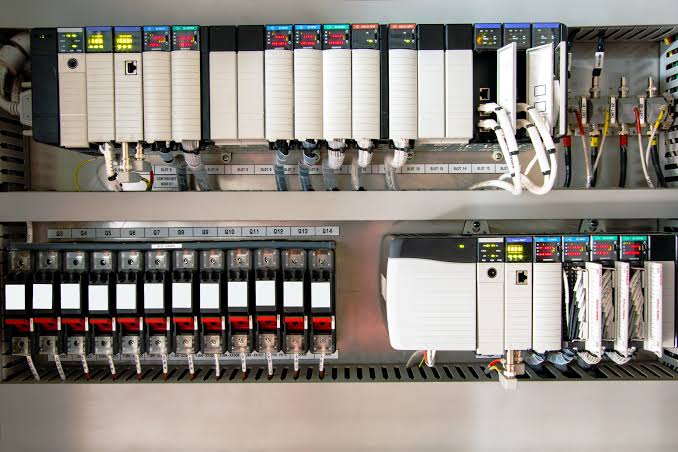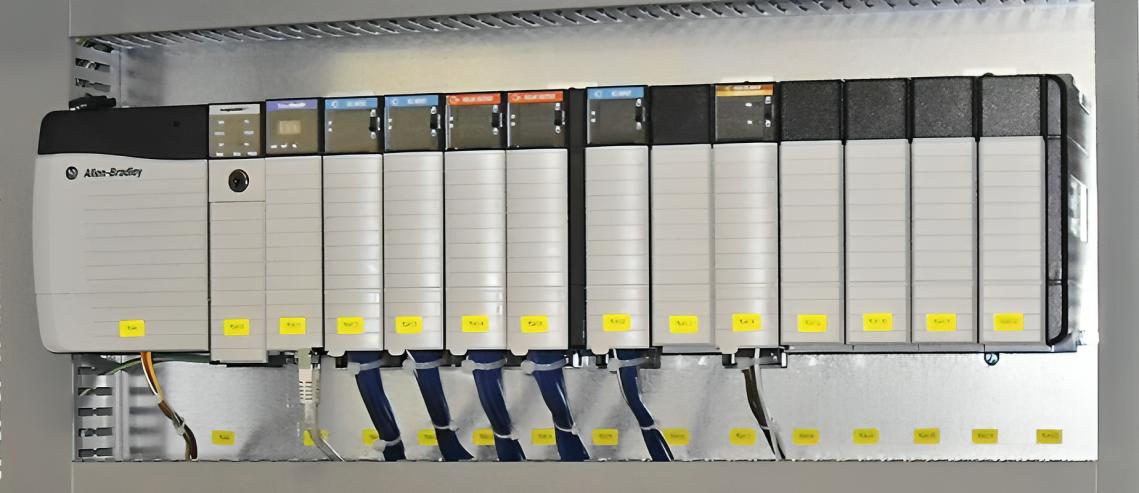In the age of industrial automation, PLC communication protocols and Programmable Logic Controllers (PLCs) play a pivotal role in controlling and monitoring machinery and processes. PLCs rely on efficient communication protocols to exchange data and instructions with other devices in the industrial environment.
This blog post delves into the world of PLC communication protocols, exploring their significance, types, and how they contribute to seamless automation in diverse industries.
Importance of PLC Communication Protocols
PLCs act as the brain of industrial automation systems, executing tasks based on programmed logic.
However, for them to function effectively, they need to communicate with various devices such as sensors, actuators, and Human-Machine Interface (HMI) systems.
Communication protocols serve as the language that facilitates this interaction, allowing for the exchange of data and commands in a standardized and efficient manner.

Types of PLC Communication Protocols:
1. Serial Communication Protocols:
Serial communication involves the transfer of data one bit at a time over a single communication line. Common serial communication protocols for PLCs include RS-232, RS-485, and Modbus.
RS-232 is a standard for serial communication between devices within short distances, while RS-485 is suitable for longer distances and allows for multi-device communication on the same network.
Modbus, on the other hand, is a widely used open-source protocol that enables communication between PLCs and various industrial devices.
2. Ethernet-based Communication Protocols:
With the evolution of industrial networks, Ethernet-based communication protocols have gained prominence.
Protocols such as EtherNet/IP, Profinet, and Modbus TCP operate over Ethernet networks, offering higher data transfer rates and improved reliability. EtherNet/IP, developed by ODVA, is widely adopted in industries for its compatibility with both standard Ethernet and TCP/IP.
3. Fieldbus Communication Protocols:
Fieldbus protocols are designed to connect field devices, such as sensors and actuators, directly to the PLC.
Profibus and DeviceNet are examples of widely used fieldbus protocols.
Profibus supports high-speed communication and is suitable for complex industrial environments, while DeviceNet, developed by the Open DeviceNet Vendors Association (ODVA), is known for its ease of use and compatibility with various devices.
4. Wireless Communication Protocols:
As industrial automation systems evolve, wireless communication protocols are becoming increasingly popular.
Wireless HART and ISA100.11a are examples of protocols designed for wireless communication in industrial environments.
These protocols eliminate the need for physical cables, providing flexibility and cost savings in installation.

Role of Communication Protocols in Industrial Automation:
- Real-time Data Exchange:
PLC communication protocols facilitate real-time data exchange between PLCs and other devices. Real-time communication is crucial in industries where instantaneous decision-making is required, such as in manufacturing processes or critical control systems.
2. Interoperability:
In a diverse industrial ecosystem, different devices from various manufacturers need to work seamlessly together. Standardized communication protocols ensure interoperability, allowing PLCs to communicate with devices from different vendors without compatibility issues.
3. Remote Monitoring and Control:
Many modern communication protocols enable remote monitoring and control of industrial processes. This capability is essential for industries where accessibility to machinery or processes is limited, allowing for efficient troubleshooting and maintenance.
4. Scalability:
Communication protocols play a vital role in the scalability of industrial automation systems. As processes expand or new equipment is added, the chosen protocols should support the increased demand for data exchange and communication.

Challenges and Considerations:
- Security Concerns:
With the increasing connectivity of industrial systems, security becomes a paramount concern. Implementing secure communication protocols and adopting best practices for cybersecurity is crucial to prevent unauthorized access and potential threats.
2. Compatibility Issues:
In a diverse industrial landscape, ensuring compatibility between different devices and systems can be challenging. When selecting communication protocols, it’s essential to consider the compatibility with existing equipment and future scalability.
3. Reliability and Redundancy:
Industrial processes often require high reliability and minimal downtime. Communication protocols should be chosen or designed to ensure reliability, and redundancy measures should be in place to prevent communication failures.
Future Trends in PLC Communication Protocols:
- Integration with IIoT:
The Industrial Internet of Things (IIoT) is transforming industrial processes by enabling enhanced connectivity and data exchange. PLC communication protocols are evolving to integrate seamlessly with IIoT, allowing for more extensive data analytics, predictive maintenance, and improved overall efficiency.
2. 5G in Industrial Automation:
The deployment of 5G technology in industrial automation is anticipated to revolutionize communication. With its high data transfer rates, low latency, and support for massive device connectivity, 5G will enhance PLC communication protocols, especially in applications requiring real-time control and monitoring.
3. Edge Computing:
Edge computing is gaining traction in industrial automation, bringing computation and data storage closer to the devices generating data. PLC communication protocols are adapting to support edge computing, enabling faster decision-making and reducing the burden on centralized systems.
Conclusion:
In the dynamic landscape of industrial automation, PLC communication protocols play a pivotal role in ensuring seamless data exchange, control, and monitoring.
As industries continue to evolve, the choice and implementation of these protocols will be critical in achieving efficiency, reliability, and adaptability.
Understanding the types, roles, challenges, and future trends in PLC communication protocols is essential for engineers, system integrators, and decision-makers in the field of industrial automation.
Home Page Our Face Book Page Our You Tube Channel